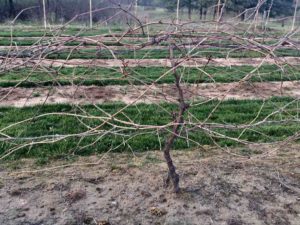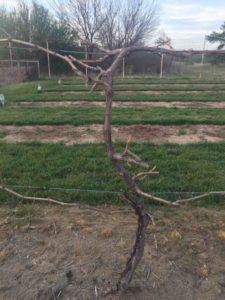
We finished pruning our grapes this week. Every spring it is a dramatic affair because of how much plant material we remove. Next year’s production comes from this year’s growth. Way more material is produced in one year than the grape-vine is able to handle. If left unpruned, a typical grape-vine will produce small grapes, and be highly susceptible to disease and insects. Not only will multiple vines arise all along the main trunk, but new growth will originate at the terminus of last year’s production laterals. Left unpruned several years these laterals will travel down the trellis fifty feet or more. The vines pictured here are three-year-old plants, and are a Concord-type variety called Fredonia. It makes wonderful juice for cider or jelly.
Pruning grape-vines is kind of like working a jig saw puzzle, or filling out a Sudoku puzzle. You want to pick the four best lateral arms to tie along the trellis, but all of the lateral are far longer than necessary, so long that they extend over into the spaces of the neighboring plants. You have to carefully determine which laterals are connected to the particular vine you are currently working on and which are connected to the adjacent (or beyond) plant. Careful multiple cuts are necessary to insure the best four “arms” are selected for each vine.

Okay, here is what the finished product looks like. You would be surprised, but by the end of the season you are back where you started with a tangled mess. We even prune multiple times throughout the summer to promote adequate air flow around and through the vines.
We usually wait to prune until leaf buds begin to emerge, so gently untangling the intertwining laterals is a must. Another issue is having to sometimes make a lateral branch snaking off to the right (or left) and force it to the left (or right) because no logical option exists. When it comes to pruning grapes, slow and steady wins the race.